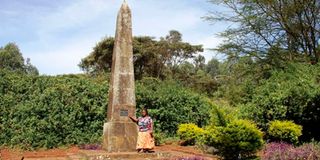With Karen Blixen to her lover’s grave

The obelisk and Damaris at Denys Finch Hatton’s grave site.
What you need to know:
- When we got to the T-junction in Ngong Town, Google instructed me to turn right, rather than left to Kiserian.
- Then, avoiding the right turn to Suswa, we looped left, drove past the government offices and stayed on the same road beyond the tarmac for about six kilometres.
I have another ghost story for you. A good one. I hope you think so too. The ghosts of Kenya’s past must have been talking amongst themselves.
Like for a few others, I had a visitation the other day. It was the ghost of Karen Blixen. ‘I am jealous of Elspeth Huxley,’ she said. ‘You took her on a trip back to Thika. I want to visit the grave of Denys Finch Hatton. You will be aware that that aristocratic adventurer had a very special place in my life. Will you take me there? You must know there will be no problem. No-one but you will be able to see or hear me.’
I couldn’t say No, could I?
So, last Sunday, we drove to the Ngong Hills. ‘I have ghosted around my old Bogani House, now the Museum named after me, and I have sat incognito at the Karen Blixen Coffee Garden – both wonderful places. But I couldn’t find the grave site up on the hills’.
‘Don’t worry,’ I reassured her. ‘I haven’t been there for years, but I have the Google map and directions.’
On the way, she was very ready to chat.
‘You will have read my Out of Africa, so you will know how we chose that site. It was at the time that we were very close. And it was when I thought I would live and die in Africa. There was a place high up the hills that I pointed out to Denys as where I would wish to be buried. In the evening at Bogani, as we were sitting and looking up at the hills, Denys said that he would also like to be buried there. Quite often after that, Denys would say, ‘’Lets drive up the hills to our graves’’’.
When, on Sunday, we got to the T-junction in Ngong Town, Google instructed me to turn right, rather than left to Kiserian. Then, avoiding the right turn to Suswa, we looped left, drove past the government offices and stayed on the same road beyond the tarmac for about six kilometres.
Karen was excited. ‘So many people,’ she said. ‘So many people! In my time there were no buildings up here. It was a game reserve.’
Then Google failed me. We were at the pin place, but there was no sign. However, the youngsters on the road all knew about Finch Hatton’s grave. One of them hung on the side of the Defender and guided me up a narrow lane called Naserian Road. At the site, Damaris was waiting by the gate. I had rung her the evening before. (And if you also want to visit, I advise you to do the same. Her number is 0723-758639.)
There was the obelisk, erected alongside the grave and surrounded by a well-tended garden. There was the plaque on the obelisk, with the lines from one of Denys’ favourite poems, Coleridge’s The Rime of the Ancient Mariner: ‘He prayeth well, who loveth well both man and bird and beast’.
What happened then must have been an incredible experience for Karen’s ghost. Damaris said she was the great granddaughter of Kamante, who had been Karen’s cook – someone who she writes about a lot in Out of Africa.
It seems that before she went back to Denmark, Karen had persuaded the government to allocate land to Kamante, and she had asked him to look after the grave. She must have wanted to embrace the girl, but she couldn’t.
On the way back, I asked Karen if she ever made ghostly contact with Denys. ‘Very little,’ she said. ‘You will know he hunted women as well as elephants. I think he still has contact with that flirt, Beryl Markham – the woman who was a pilot like him. He will say all they do is talk about flying. But when next I meet up with him I will certainly tell him about this trip.’
John Fox is Chairman of iDC Email: john [email protected]





